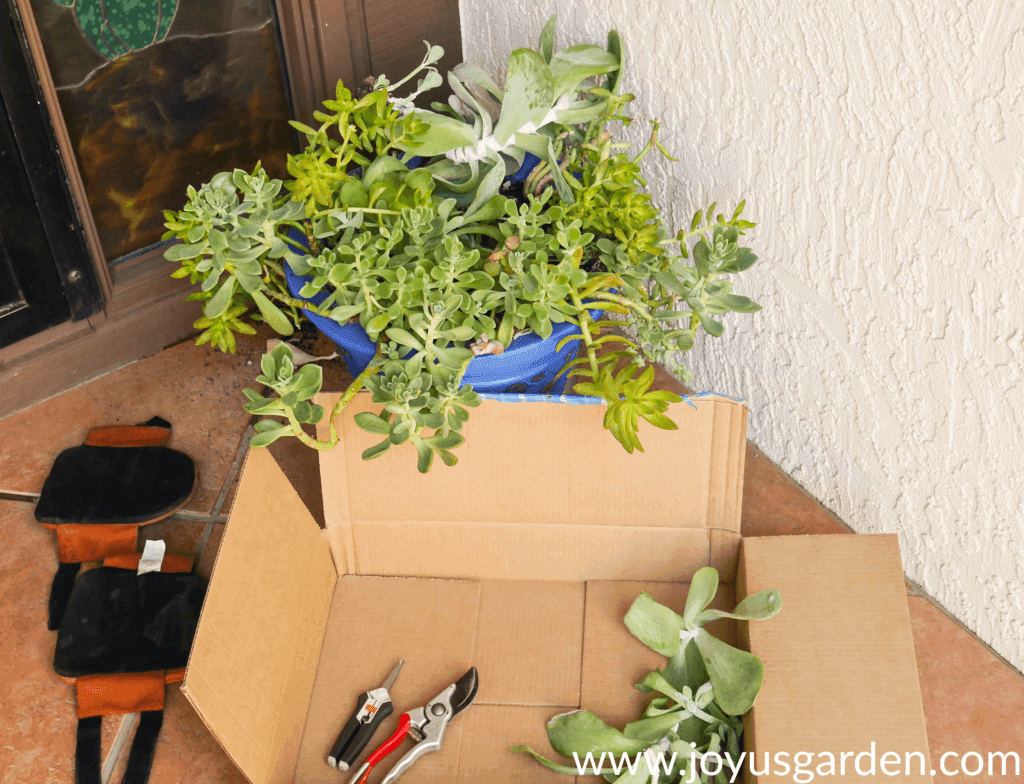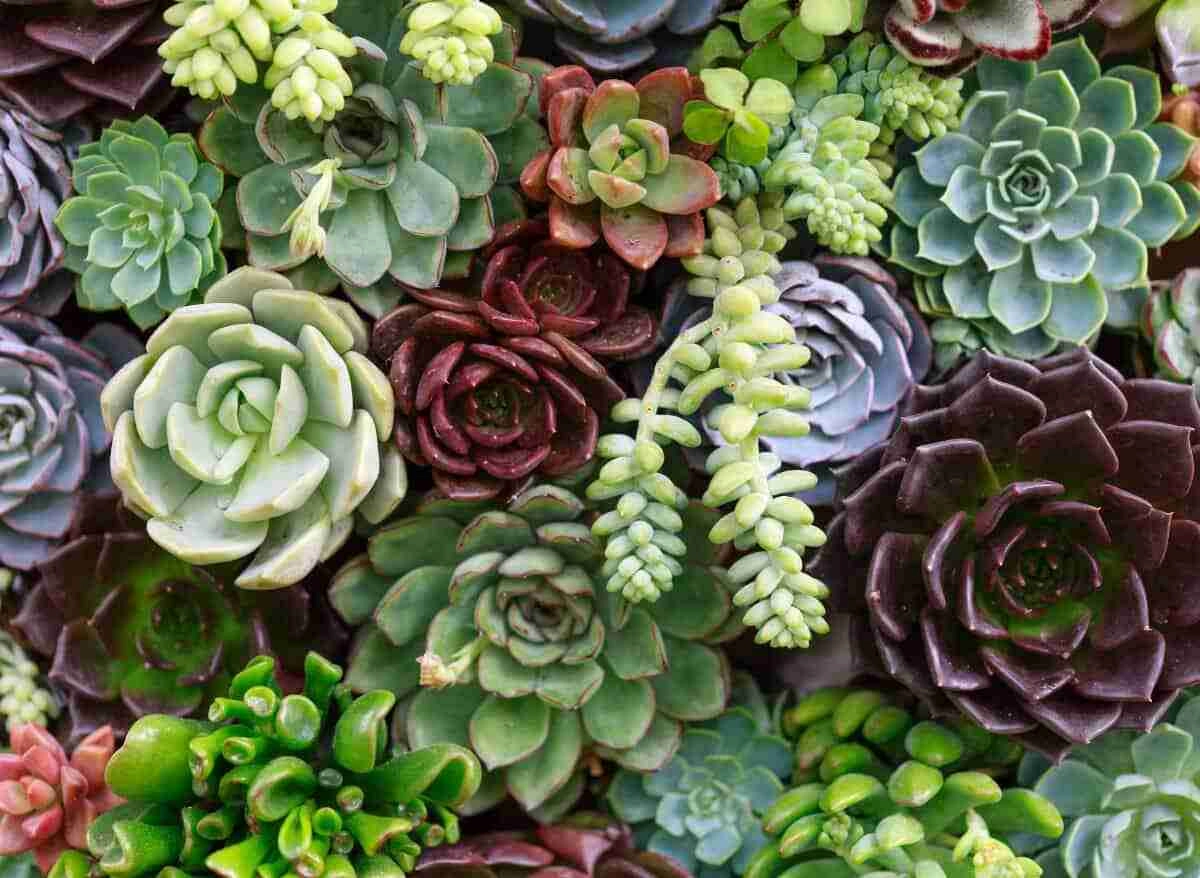Succulent plants get leggy from time to time. Keep reading to learn why it happens and what you can do about succulents with long stems.
We love you, beautiful succulents, but why do your stems get so long? I had a lot of them in my garden in Santa Barbara, so it didn’t bother me when they did that. They intertwined, co-mingled, and propped each other up. Every once in a while, I’d cut some back to propagate and/or give away.
I now live in Tucson, which isn’t the optimal climate for growing fleshy succulents. Mine grow in pots; some can look sad when that intense summer heat rolls in. They all grow in the shade because they can’t handle the hot sun here. One of my succulent plants (shown below) needed to have all of its stems cut back because they were getting too long, skinny, and stretched out.
Succulents are popular houseplants known for their drought tolerance and diverse textures. From rosette-forming echeverias to trailing string of pearls, these plants thrive with minimal care when given proper conditions. However, succulents will often start growing long, pale stems, stretching upwards away from their compact form. This common issue, called etiolation, occurs when the plants don’t get adequate sunlight. Luckily, identifying and fixing etiolated succulents is quite simple. This guide covers everything you need to know about succulent plants growing long stems and how to help them return to their natural beauty.
What is Etiolation in Succulents?
Etiolation refers to abnormal elongated growth in succulents and cacti caused by insufficient light exposure The technical term comes from the French word “étioler” meaning to bleach or whiten Without enough sun, succulents start to stretch and become leggy as they desperately seek out light sources to fuel growth and photosynthesis.
Signs of etiolation include:
- Long, weak stems
- Sparse, pale leaves
- Leaves farther apart than normal
- Increased space between leaf pairs on rosettes
- Floppiness and inability to stand upright
This etiolated growth forms a stark contrast to the compact, vividly colored leaves of a healthy succulent. While not harmful etiolation makes succulents appear unwell and compromises their natural beauty. The good news is etiolation can be fixed with a few simple steps.
Common Causes of Etiolation in Succulents
Insufficient sunlight is by far the most common trigger for etiolated growth in succulents. But what exactly constitutes “insufficient” light? Here are some common causes of etiolation:
- Growing indoors near a window lacking bright light
- Sitting too far from a window or light source
- Light blocked by curtains, blinds, or other objects
- Shaded outdoor location lacking 6+ hours of sun
- Sun intensity reduced in winter or due to obstacles
- Natural light replaced with weak artificial lighting
Succulents prefer full sun and need at least 6 hours of intense light daily for compact growth. Even a bright window may not provide enough sunlight especially in winter when light levels drop. Always observe your succulents to see if they show signs of needing more light. Catching etiolation early makes it much easier to correct.
How to Fix Etiolated Succulents
The key to fixing an etiolated succulent is providing adequate sunlight to encourage tight, compact new growth. Here are some tips:
-
**Move to a brighter location.**Rotate the plant frequently so all sides get sun.
-
Add a grow light. Use an LED full spectrum grow light to supplement natural sunlight.
-
Trim off pale leaves and stems. Cut back to just above the healthy, most compact growth.
-
Allow cut ends to heal. Let sit for 2-4 days before replanting to prevent rot.
-
Repot in fresh cactus/succulent mix. Bury trimmed stems to reroot and form new rosettes.
-
Fertilize lightly. Use half strength balanced liquid fertilizer to support new growth.
With proper care, your succulent will soon produce colorful compact new leaves and stems. Continued ample sunlight prevents return of etiolation.
5 Tips to Prevent Etiolated Succulent Growth
Providing adequate sun is the number one way to prevent succulent etiolation in the first place. Here are 5 tips to keep your succulents happy and healthy:
-
Situate plants in a south-facing window for maximum natural light.
-
Turn plants frequently so all sides get direct sun exposure.
-
Move outdoor succulents to full sun locations with 6+ hours of direct sunlight.
-
Use sheer curtains or move plants back from windows to prevent sunburn.
-
Supplement with grow lights if indoor natural light is inadequate.
The most common succulent etiolation mistakes involve insufficient sunlight intensity and duration. Get to know your succulents’ light needs and make adjustments as needed to keep them compact.
How to Identify Etiolated Succulent Varieties
Some succulents are more prone to etiolation when kept as houseplants. Here are a few to watch for leggy growth:
- Echeveria – Rosette-forming types stretch and spread out.
- Aeonium – Long bare stems and smaller heads.
- Sedum – Spacing between tightly packed leaves increases.
- Sempervivum – Leaves spread out on the rosette.
- Senecio – Normal bushy growth becomes leggy and sparse.
- Crassula – Compact plants stretch and leaves diminish.
- Kalanchoe – Leaves separate and stems elongate.
Pay extra attention to sunlight needs for these succulents. Provide supplemental lighting if required to prevent etiolation.
When to Prune Leggy Succulent Growth
Once succulent plants start elongating, the best way to restore their appearance is by pruning leggy growth. Time pruning to early spring through summer when plants are actively growing.
- Use sterile, sharp pruners or scissors to cut stems.
- Trim back to just above healthy, compact growth.
- Allow 2-4 days for cuts to heal before replanting.
- Repot in a suitable container with drainage holes.
- Bury pruned stems to reroot and form new rosettes.
Your succulent will soon sprout compact new growth from the trimmed stem. Regular pruning keeps plants shapely and healthy.
Enjoying Succulents’ Natural Beauty
When provided with ample sunlight, regular watering, and well-draining soil, succulents reward gardeners with their stunning colors, textures, and forms. Just a bit of attentive care enables you to enjoy these plants at their most beautiful natural state. If elongation occurs, a little pruning and extra sunlight quickly fixes the issue. With this guide’s help identifying, treating, and preventing stretched growth, you can successfully grow gorgeous succulents in any indoor setting.
When To Prune Succulents With Long Stems?
Spring and summer are the best times. If you live in a temperate climate like me, early fall is fine too. Don’t bring your succulents outside until the weather gets cooler. This will give them time to settle in and grow roots.
Here’s a general guide to pruning succulents.

Why Should You Cut Back Stretched Out Succulents
Once a succulent stem gets bare, the leaves won’t grow back on it. It needs to be cut back and either grown from stem cuttings or from the base (the piece of stem with roots still in the soil).
How far you cut back depends on how leggy it has gotten and where foliage growth has stopped.
You may need to go down to the base of the plant to cut. That’s what I did with my Paddle Plant patch. I cut the stems off where new plants had grown from the base.
Fix A Leggy Succulent EASILY
FAQ
What is the long sprout coming out of my succulent?
What is the stem coming out of my succulent?
Why is my plant growing a long stem?
Why do succulents grow long stems?
Succulents will grow long stems when they are not getting enough sunlight. This process is called etiolation, where they turn and stretch out in search of light, giving them a “leggy” appearance with a long stem and smaller, spaced-out leaves. Since all plants are different, it can be hard to know right away how much light your plant needs.
What are some long stemmed succulents?
Some of the long-stemmed succulent varieties are as follows: Sedum: Also known as stonecrop, Sedum plants are known for their fleshy leaves and long, trailing stems. They come in various colors and are great for hanging baskets or cascading over walls.
Do succulents grow longer?
There are succulents that naturally grow longer than their counterparts. Among popular succulents, we can pick Burro’s Tail, String of Pearls, and Agave . All these beauties naturally grow longer stems, and if you do not like to see it, you can always prune them to get them to the preferred size. Another reason is lack of light.
Will a succulent die if it grows a long stem?
By growing a long stem, the succulent is searching for more sunlight and as long as you provide that, the succulent will recover and survive. However if the sunlight need it not met, then yes the succulent will eventually die. Can I Revert My Elongated Succulent?
- The Ultimate Guide to Growing Strawberries in Raised Beds - August 8, 2025
- No-Dig Garden Beds: The Easiest Way to Grow a Beautiful Garden - August 6, 2025
- How to Protect and Preserve Wood for Raised Garden Beds - August 6, 2025

